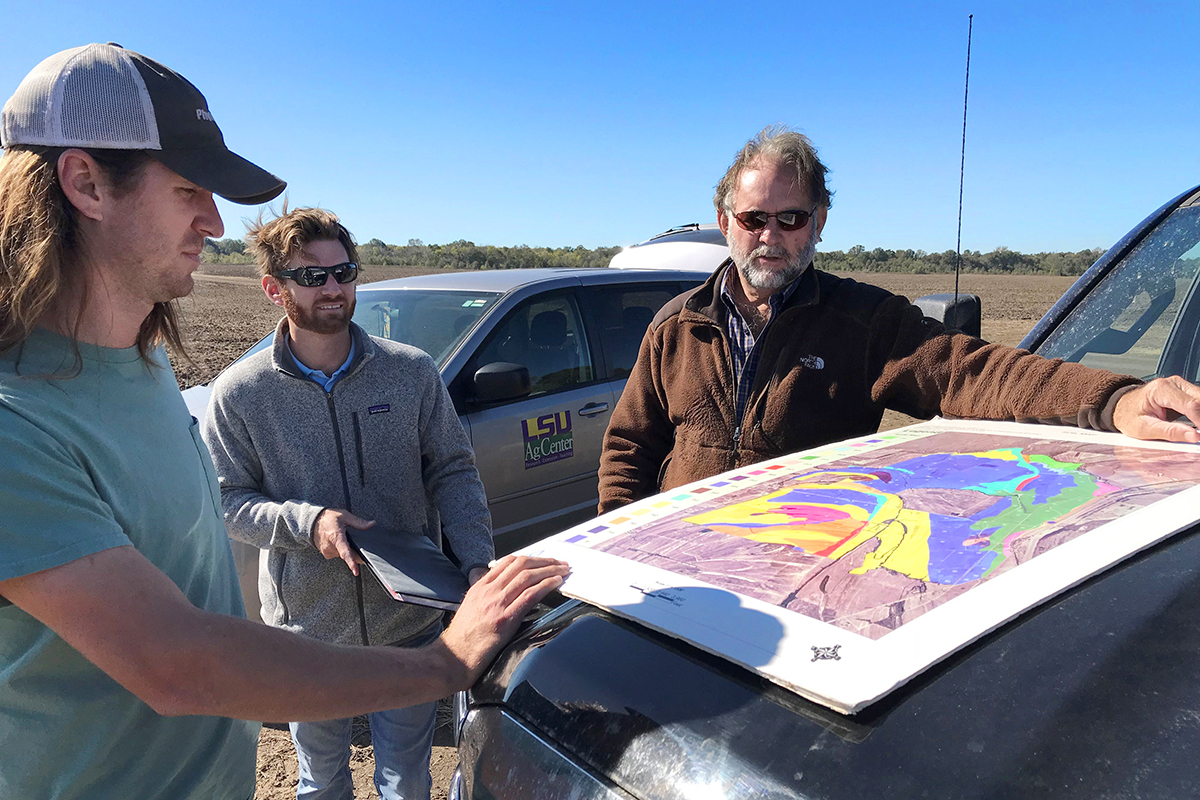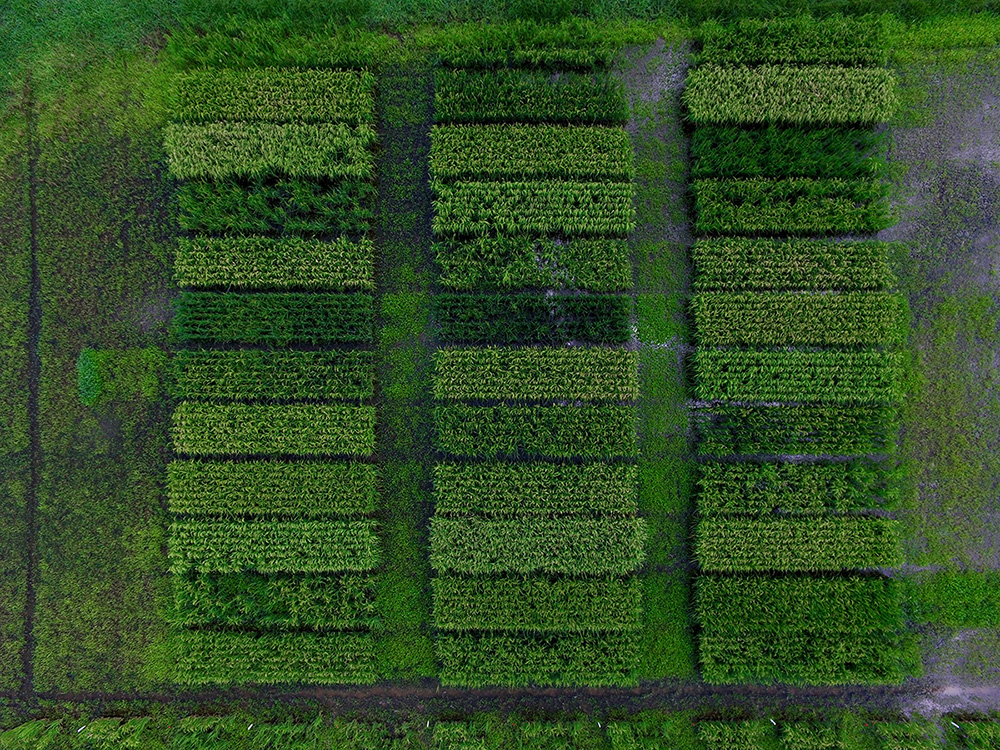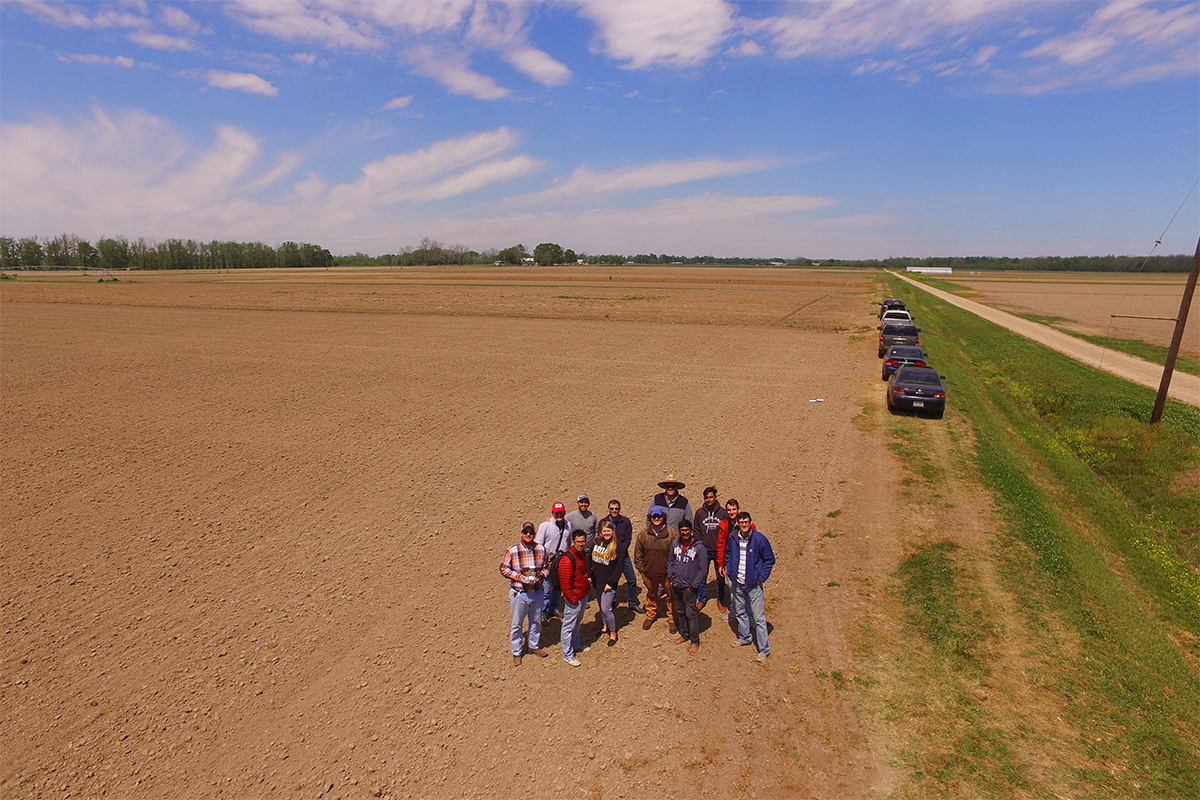“We Just Call It Work”
Farmers across Louisiana rely on LSU AgCenter’s cutting-edge research and technological advances in what’s now called precision agriculture—using remote sensing, machine learning, and big data on farms—to get bigger yields and larger profits while protecting the environment for future generations. But some just call it work.

Marshall, Mead, and Jay Hardwick farm on 8,000 acres in Tensas Parish. By collaborating
with LSU and the AgCenter and benefiting from recent research and development in precision
agriculture, including satellite imaging and data analysis, the family has been able
to save money on inputs (seed, fertilizer), get bigger yields, and minimize their
impact on the surrounding ecosystem.
Kyle Peveto
Mead Hardwick is a fourth-generation farmer in Tensas Parish in the northeastern part
of the state, a couple of miles from the Mississippi River, along Highway 65. He farms
with his brother Marshall and his dad, Jay Hardwick. When invited to a Zoom meeting,
he joins via video link from his tractor. Why not? The tractor practically drives
itself and although Hardwick does have to turn it around when he reaches the end of
the field, he’s surrounded by technology to help him and his family optimize every
bit of energy and money they spend across Hardwick Planting Company’s 8,000 acres
on a portion of Somerset Plantation’s 20,000 acres. The tractor has real-time kinematic
(RTK) auto-steer and doesn’t swerve more than an inch to the left or right; there’s
a GPS receiver on the roof; and right behind, there’s a variable-rate fertilizer applicator
that’s pre-programmed to release specific amounts only in certain areas according
to a “prescription map” loaded into the tractor’s on-board computer. On a colorful
screen by the steering wheel, Hardwick can watch himself like an avatar advancing
through the harvested soybean field where the colors on the map show differences in
nutrient levels.
Modern farm machinery not only harvests crops but also lots and lots of data. As Hardwick
chats about various projects on Zoom, his tractor and other machines can record information
about the soil and the crop and link it automatically to longitudes and latitudes.
He doesn’t have to walk or drive up and down each row with a clipboard to take notes
like “Need more fertilizer on this area about two-thirds of the way down.” The tractor
knows exactly where it is and what is needed.
“We’ve had a long relationship with LSU and the AgCenter,” Hardwick said. “LSU has
helped us find the sweet spot with our variable rate fertility program and how to
have truly sustainable agriculture. Working with LSU has also helped me be confident;
they’ve answered questions and given us access to tools we otherwise would not have.
When we want to test something, it’s ‘Here’s an idea,’ and ‘Let’s go do this.’ Having
this relationship with LSU on gathering and analyzing data and really understanding
the numbers has been seamless.”
“We work hard to make the knowledge tangible; we have to. Otherwise, when we go to a farmer, he’ll say, ‘I can’t apply that, I can’t spend the money,’ and the farmer will then decide to do something else. Just like people talk about evidence-based medicine, we try to do evidence-based agronomy—using actionable data that’s customized for each grower, we can provide what-if scenarios and show exactly how much profit is possible by doing one thing as opposed to another.”—Luciano Shiratsuchi
Hardwick wasn’t destined to become a farmer, nor was his father, Jay Hardwick, who
was a college arts professor in photography until he and his wife Mary decided to
move back to Louisiana to join her family farm in 1981.
“My dad didn’t know a corn plant from a cotton plant when he started,” Mead Hardwick
said. “So, he had to latch onto something that quickly could get him up to speed.
Luckily, he had LSU and the AgCenter Northeast Research Station, which is only about
13 miles from our farm.”
Mead Hardwick himself worked in the finance world and real estate development in Dallas,
Texas until 2014.
“I should maybe say this off the record, but I actually had an overlap for about a
year between farming and real estate because I honestly wasn’t sure if this farming
thing was going to pan out,” he said.
But it did, and he now looks forward to his own children becoming the fifth generation
of the Hardwick Planting Company, which also encompasses forest as a natural wildlife
refuge for the Louisiana black bear. On their 8,000 acres of tillable farmland, the
family grows soybeans, lots of corn and cotton, and smaller amounts of winter wheat
and grain sorghum.
When it comes to his and his dad’s relative inexperience with farming in the beginning,
Mead Hardwick considers it an asset.

Drone footage of test plots in a rice field. By using artificial intelligence and
training a computer system to recognize the edges of fields and planted areas and
then analyzing those areas for plant vigor, Thanos Gentimis, assistant professor in
the LSU AgCenter Department of Experimental Statistics, helps farmers capture information
not yet visible to the human eye—pinpointing spots that might need more seed or fertilizer.
Photo courtesy of Thanos Gentimis
“What has allowed us to move into some really advanced things and experiment based
on the latest in technology and research with LSU is that we got to break the cycle
of ‘Dad did it this way’ or ‘Dad did it that way’ and really take a different approach,”
he said. “The younger farming generation like myself sometimes struggle to convince
the older generation to move forward, so we’re fortunate. The kind of experimentation
we’ve done can’t go on if you’re fighting an intragenerational technology battle.
That’s how we got to doing precision agriculture and getting the equipment that has
enabled us to embrace it fully.”
While Jay Hardwick had no prior experience in agriculture, he quickly got up to speed.
He’s now one of the most well-known farmers in the state and was just inducted into
the Louisiana Agriculture Hall of Distinction, which recognizes those who have made
significant contributions to Louisiana’s farming, ranching, forestry, aquaculture,
education, and agribusiness industries. He was recognized for having made cotton farming
more environmentally friendly by focusing on production techniques that have minimal
impact on the surrounding ecosystem. Jay Hardwick has previously received the National
Cotton Achievement Award, the National Award for Environmental Sustainability, and
the U.S. Environmental Protection Agency’s Environmental Excellence Award. He also
serves as chairman of the American Cotton Producers of the National Cotton Council.
The Hardwicks work in close collaboration with Precision Ag Coordinator Luciano Shiratsuchi,
associate professor in the LSU School of Plant, Environmental & Soil Sciences, and
Thanos Gentimis, assistant professor in the LSU AgCenter Department of Experimental
Statistics. While Shiratsuchi is an agronomist, Gentimis is not—he’s a mathematician
who also happens to be quite good at chess. LSU AgCenter hired both of them to help
launch the university’s digital agriculture program in 2018 and interest among students
has skyrocketed. Gentimis came from health informatics and now is applying the same
expertise (machine learning, artificial intelligence) to improving agriculture, so
it’s not lost on him nor his students that the toolboxes they’re building could be
valuable in many contexts. A recent graduate got a job as a data analyst to help improve
the safety of Louisiana buildings.
By using machine learning and artificial intelligence, Gentimis is developing software that can learn from outcomes on one farm or with one particular crop or variety to make predictions for others. It’s all about pattern recognition.
Using vast datasets, Gentimis trained a computer system to recognize the edges of
fields and areas with different amounts of vegetation based on drone and satellite
images (remote sensing). Next, each defined area is analyzed for plant vigor—the normalized
difference vegetation index, or NDVI, can measure plant health and capture information
not yet visible to the human eye—pinpointing spots that might need more seed or fertilizer
and getting that information to the farmer in real time. The biggest advantage Hardwick
sees in this approach is its incredible speed, in two ways. First, he can buy a satellite
image of their vast farm, use it to generate a prescription map, and have the tractor
out rolling in the field the next morning, applying what’s necessary. Second, the
research findings from Shiratsuchi and Gentimis are already at scale—there’s no need
to translate or extrapolate from research results in a lab or on a small test patch
to the 8,000-acre farm.
“Anytime somebody comes up with an idea in a lab or a small plot, you say, ‘Those
are very positive results, but can that be replicated on a large scale?’,” Hardwick
said. “That’s not to say research isn’t always useful—it gives you an idea of what’s
possible. But it often has a ways to go before you can translate it on the farm and
it becomes economically viable. Also, what we’re trying to figure out is what we can
do today—not tomorrow, but today. With the tools I have in my toolbox, what will that
let me do today?”
Here, he speaks the same language as Shiratsuchi.
“We work hard to make the knowledge tangible; we have to,” Shiratsuchi said. “Otherwise,
when we go to a farmer, he’ll say, ‘I can’t apply that, I can’t spend the money,’
and the farmer will then decide to do something else. Just like people talk about
evidence-based medicine, we try to do evidence-based agronomy—using actionable data
that’s customized for each grower, we can provide what-if scenarios and show exactly
how much profit is possible by doing one thing as opposed to another.”

Drone photo of LSU students studying precision agriculture with Luciano Shiratsuchi
and Thanos Gentimis. The students come from various disciplines—animal sciences, renewable
natural resources, mathematics, experimental statistics, computer science, entomology,
as well as plant, environmental, and soil sciences. From left to right (front row)
Felippe Hoffman, Silva Karp, Prakash Dangal, Korey Nuchia, Hugh Bullard, Sumanth Vissamsetty),
Benjammin Meritt; (back row) Daniel Forestieri, Murilo Martins, Thanos Gentimis, Kelly
Arceneaux, Lovepreet Singh, and Alexander Tryforos.
Photo courtesy of Thanos Gentimis
The amount of data processing necessary, however, cannot be done on a regular computer.
Gone are the days of “let me check the books” or transferring years of farm data on
a flash drive.
“The massive tangle of raw data that comes from precision agriculture is like a fertile
field full of potential but, just like in farming, if the right tools and seeds are
not used, the field will never produce much,” Gentimis said. ”We believe the right
tools can be found in data analytics and machine learning, since the datasets involved
have long surpassed the abilities of traditional models for analysis and prediction.”
To meet the research program’s needs for high-performance computing, Gentimis combines
local servers with resources in the cloud. He and Shiratsuchi also collaborate closely
with industry. Ag-Analytics, a farm management platform led by former Cornell University
associate professor Josh Woodard has quickly developed a global reach in helping farmers
improve efficiency by melding automated sensor data from farm equipment with satellite
imaging and machine learning. When the Ag-Analytics team launched their university
partnerships, they came to LSU first.
“We went to where the top researchers were, and it’s become a great partnership,”
Woodard said. “Farmers on our platform have an option to confidentially share aggregated
datasets with researchers at their land-grant university. Our system translates and
calibrates the data so we can layer it all onto one cohesive geospatial grid to make
predictions in real time to help farmers and support the land-grant extension system.”
The crops Shiratsuchi and Gentimis have focused on optimizing so far are sugarcane,
soybeans, rice, corn, cotton, sweet potatoes, wheat, and sorghum—industries with an
estimated total annual economic impact of about $6.4 billion.
“Short of launching hybrids that don’t need fertilizer, precision agriculture is the
only way for farmers to save money and the environment, using fewer resources while
getting the same or better yield,” Shiratsuchi said. It’s the only practical way to
improve efficiency and reduce contamination, using only what you need and where you
need it.”
Mead Hardwick agrees.
“We grow commodity crops for which there is a set market price,” he said. “We can’t
do much about the price, so to increase our profitability, we need to control our
cost, produce more, and be more efficient. Being strategic with our nutrients, especially,
has been key for us. It feels good, too, considering how nutrient runoff contributes
to the ‘dead zone’ in the Gulf of Mexico.”
When the Mississippi River meets the Gulf of Mexico, it brings agricultural runoff
from about a third of the country with it, as far north as Minnesota. When fertilizer,
such as nitrogen and phosphorus, hits the Gulf, it’s a feast for algae, which multiply.
But as the algae die and decompose, they consume the oxygen in the water, causing
“dead zones” void of aquatic life. This low-oxygen condition is known as hypoxia,
and the Hardwicks and the LSU AgCenter are currently involved in a four-year research
project funded by the Patrick F. Taylor Foundation to help solve this problem.
“Overall, in America, we’re still applying much more nitrogen than we need,” Shiratsuchi
said. “But you don’t gain anything from applying the same blanket amount across the
board; instead, you lose. You can’t treat the farm as a uniform field and use averages
for everything.”
By using machine learning and artificial intelligence, Gentimis is developing software
that can learn from outcomes on one farm or with one particular crop or variety to
make predictions for others. It’s all about pattern recognition. And while we’re still
far from “self-driving farms,” the benefit of data-driven “smart farms” is becoming
clearer each day—especially as rapidly changing environments make it harder and harder
to rely on experience.
Even when something goes terribly wrong, precision agriculture technology can help.
When Hurricane Laura wreaked havoc in southwestern Louisiana this August, farmers
and insurance agents were able to assess and document the damage faster using remote
sensing, so insurance payments could go out.
Advanced data analytics will increasingly become part of any “normal” day on the farm,
researchers and farmers predict.
“I love tech, but I don’t think of it as ‘tech’ or ‘precision agriculture,’” Hardwick
said. “We just call it work.”
Elsa Hahne
LSU Office of Research & Economic Development
ehahne@lsu.edu